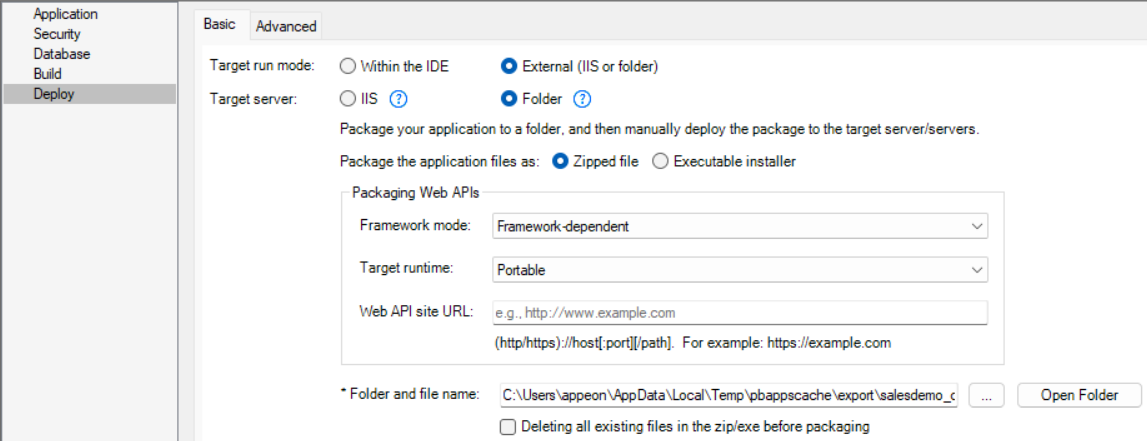After configuring the PowerServer project properly, you can build and package the installable cloud app (including the client app, cloud app launcher, PowerBuilder runtime files, and PowerServer Web APIs) into an executable installer or a zipped file.
To package the installable cloud app:
-
Go to the PowerServer project painter > Deploy page > Basic tab.
-
Select External as the target run mode, and then select Folder as the target server.
-
Specify to generate the package as an executable installer or a compressed zip file.
-
If Zipped file is selected, an appname.zip file is generated in the specified path. You can copy the zip file to the server and then decompress it to the web root.
-
If Executable installer is selected, an appname_Installer.exe file is generated in the specified path. You can copy the executable file to the server and then run it to install the application to the web root.
-
-
Specify how to package the PowerServer Web APIs.
-
Framework-dependent or Self-contained -- A Self-Contained package will not only include the app assembly files and its dependencies, but also include the .NET Core runtime and libraries. Users can run it on a machine that has no .NET Core runtime installed. A Framework-Dependent package will only include the app assembly files and its dependencies. Users have to install the .NET Core runtime in order to run the app.
-
Portable, Windows 64-bit, Linux 64-bit, or Windows 32-bit -- The target platform that the Web APIs is published for. If you know the architecture of the target server, you can select the corresponding platform; if you are not sure of the server architecture, you can select Portable. But if you select Portable, you can only select Framework-dependent.
Note
Make sure the platform of Web APIs matches with that of the server. Take IIS for example, if you select Windows 32-bit, make sure IIS is 32-bit (set "Enable 32-Bit Applications" to True); if you select Windows 64-bit, make sure IIS is 64-bit (set "Enable 32-Bit Applications" to False). For more, refer to this section.
-
Web API site URL -- If you know where the Web APIs will be running, you can specify the URL here; if you are not sure where the Web APIs will be running, you can leave this field empty and specify the URL later in the client app > apprun.json.
-
-
Specify the folder and file name where the package will be generated. You can select to delete all existing files in the zip file before packaging.
-
Save the project settings.
-
Click the Build & Deploy Project button (
 ) on the toolbar to compile the project and
generate the package.
) on the toolbar to compile the project and
generate the package.
When the build & deploy process completes successfully, the package should be generated in the output path.




